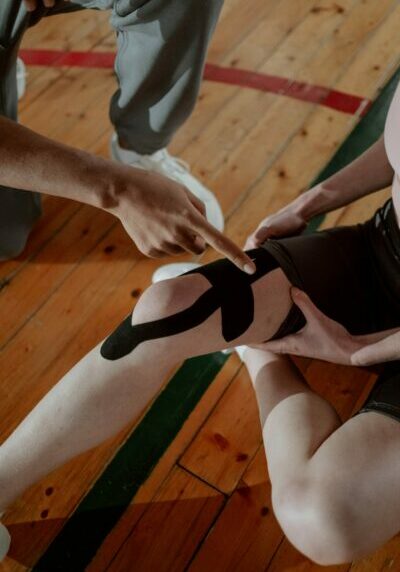Knee Pain and Fitness Training
with Injury Rehabiliation Training Specialist Anja Taljaard
Let’s talk about knee pain for a minute. More importantly, I want to discuss why it’s not just the knee you should be thinking about.Knee pain is so common that it’s estimated to affect 25% of all adults in some way, shape or form.Terms such as growing pains, meniscal tear, patellofemoral pain, arthritis etc. are all becoming more widely recognized and understood by the general public.
It’s so popular I’d be willing to bet that either you are currently suffering from knee pain, or you know someone who is.
Yet despite how common it is, we still often lack the necessary perspective to understand why it’s there in the first place. So here are some really important ideas to consider.

YOUR KNEE PAIN IS A CONSEQUENCE
As I’m sure most are aware, the knee’s primary role is to hinge backwards and forwards. However this simplistic view often does it a disservice. We often forget it’s literal connection to the ankle and hip and how heavily it’s governed by them. It’s stuck in the middle. A joint of consequence if you will.
The knee isn’t a glorified door hinge floating around on its own, it’s just one aspect of your leg. This same leg functions as part of your lower body, which functions as part of your entire body. It all works together. This tendency to miss the bigger picture can make it hard to have the right perspective when there’s pain involved.
As a sports rehab specialist it seems that most feel their knee pain just “happens”. So do accidents of course, but for the majority of us our knees are fine, until they aren’t.
Solving your knee pain is hard to do without context.
A CONSEQUENCE OF WHAT EXACTLY..?
A great way to think of knee pain is that it’s onset is likely the last straw rather than the beginning of something new.
Yes it didn’t hurt until it started hurting, but it’s role within the leg means it’s prone to compensate for hidden dysfunction above and/or below it.
Clinically, there seem to be THREE major areas of the lower body that, when restricted, will change the way your knee is loaded.

The Ankle:
Thanks to modern heeled footwear and flip flops our ankles have a tendency to be stiff.
Mechanically, a rusty ankle forces the entire leg to rotate inwards in an attempt to maintain some functional equilibrium.
This can often lead to knee pain on the inside or outside of the knee.
TRY THIS:
Squat as deep as you can while keeping your heels down and feet straight.
Next, squat again but allow your heels to lift and your feet to turn out if needed. You should find it easier the second time.
This highlights how your body will try to compensate for a tight ankle.
In the process you may notice your knees will likely track inwards relative to where your feet are pointing. This movement alters the loading pattern of your knee from that basic hinge to more of a hinge with a twist. Sure you could get down lower the second time, but in the long run you’re unknowingly asking those knees to buffer poor mechanics. Remember, they’ll cope until it they don’t. All because of something innocuous below the knee itself.

The Hip:
If the front of your hip is tight – a common side effect of prolonged sitting – the knee again has to compensate.
When walking, notice what your back leg is doing as it trails behind. Tightness at the front of the hip will ask your leg to rotate outwards to find more room. If you watch others walk you’ll notice a lot of turned out feet. This is more poor loading for the knee.
To compound this, tight hip rotators can make sitting cross-legged uncomfortable for your knees. If this is you then it’s likely your knees aren’t enjoying that lack of hip range!
The Lower Back:
Stiff lower back segments directly and indirectly influence knee function. If your back is stiff your body will tighten surrounding musculature in support.
Our hip flexors can get caught up in this drama as they sneakily attach to the front of your lower back. This again forces the leg to find a rotational work around with long-term ramifications for the knee.
Similarly, the nerves that supply the function of the knee exit here and can become physically over-tensioned. This can pull slack from, and tighten any tissue associated with the nerve as it travels down the leg. For example, if kneeling and sitting fully back on your heels is uncomfortable, it’s likely that the muscles at the front of your thighs (the Quadriceps) are tight. This restriction is often a consequence of back stiffness/increased neural tension

So with all this in mind there are some important things to remember. If you have a sore knee, or know someone who does, take a step back. Consider how your ankles, hips and low back are also going. Sure they may not immediately seem dysfunctional, but restriction in these areas holds a powerful influence over the knee. After all they share a physical and mechanical connection. It’s just often hard to appreciate if you’re not looking for it.
At the end of the day, this is a lesson in perspective. It’s important to understand that almost everything that happens to the knee is a consequence of something else. You just need to take a big enough step back to appreciate what it actually is.
If you can make positive change you’ll hopefully surprise yourself with how those knees start to feel.

